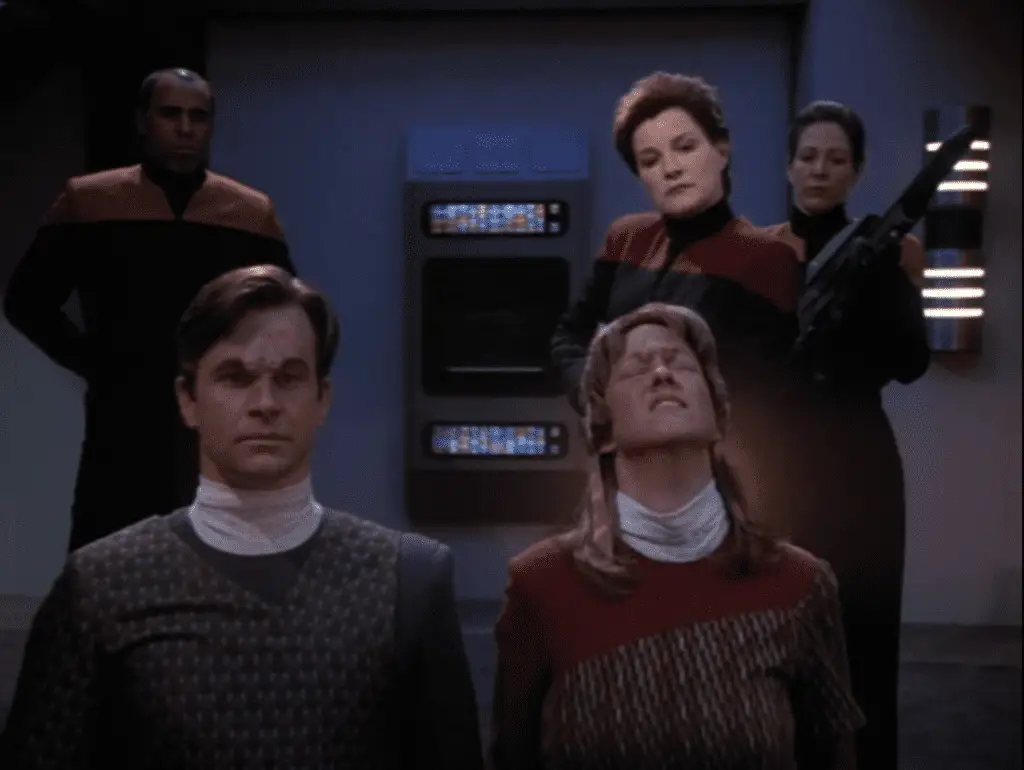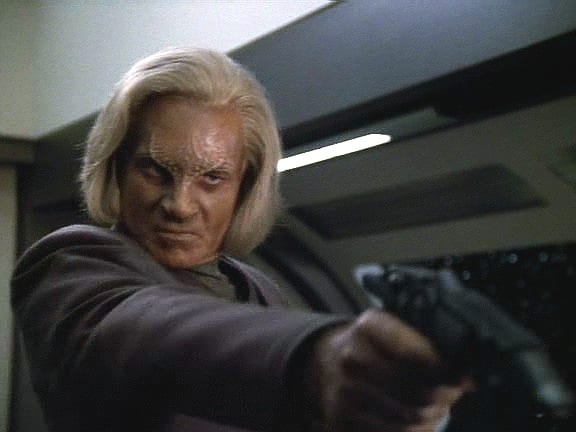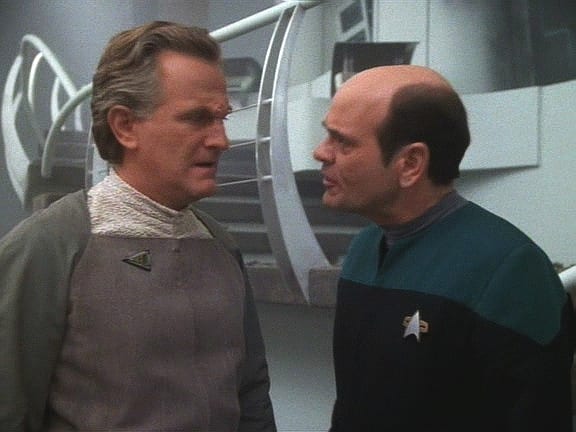Happy New Year everyone! I hope everyone had a good holiday. Today, I’d like to talk to you about a sci-fi setting near and dear to our hearts: Star…Trek. Specifically, a “message episode” of Star Trek.
A “message episode” of Star Trek is one with a particular moral applicable to modern life. The franchise has made a great deal of these sort of episodes. Many have withstood the test of time and remained good or have morals that still reverberate (Such as the Original Series episode “Day of the Dove”). Some have aged rather poorly or the message was badly told in the first place (As was the case in the Next Generation episode “The Outcast”). For me personally, there is one episode that stands head and shoulders above every other message episode. Star Trek Voyager’s season 4 episode “Living Witness”. Why this one specifically? Not only is it’s message more relevant now than ever and because it is the only one to actually acknowledge what its specific theme is: racism and Historical Revisionism.
The Voyager Encounter
The episode opens in a way that for any other show in the series, would seem like it’s taking place in the Mirror Universe. The lighting is dim on the ship , Captain Janeway is monologuing to an alien visitor about how if diplomacy fails the only answer is overwhelming force, and worst of all…she’s wearing black gloves. During the conversation Janeway reveals that she is making a deal with the alien, who identifies his species as the Vaskan. In exchange for directions to a stable wormhole, Voyager will capture the leader of another race, the Kyrians.
As Janeway walks to the bridge, viewers see more clues that show this isn’t the normal Voyager. Neelix has a console and is wearing a uniform. Captain Janeway refers to the ship as the ‘Warship Voyager’, and the doctor is an android. What’s even worse, the Captain orders the use of Biogenic weapons against civilian targets. Clearly, something is not right here.
Just before the opening titles we see what is actually going on. The Voyager we were watching was a holographic recreation of an event that apparently happened 700 years ago. The curator of the museum (a Kyrian named Quarren) tells the people watching the recreation that “Even today, seven hundred years later, we are still feeling the impact of the Voyager Encounter.”
After the opening credits, we quickly learn through exposition that according to this museum, Voyager attacked and killed the leader of the Kyrians, a man named Tedran. Tedran’s death led to centuries of Kyrian oppression under the Vaskans. In a good line of dialogue, before resuming the simulation and showing Tedran’s death, Quarren gives the visitors a content warning, telling them that this next scene will be disturbing. And it honestly is. Captured after a brief scuffle with fully Borg Seven of Nine simulation, Janeway has him brought before her and the Vaskan ambassador. She then executes him herself.

After the simulation ends, a Vaskan patron confronts Quarren, claiming that the story presented is inaccurate. That the Kyrians are always blaming the Vaskans for their problems. The patron is also quick to point out that he doesn’t have a problem with Kyrians. Some of his friends are Kyrian after all! It’s at this point in the episode, a little over a third of the way into it, that we start to see that theme of racism start to appear. It will remain a background element for a while though, simmering and only really making itself known near the end of the episode.
Later, after the museum closes for the night, Quarren starts working on a new Voyager artifact. He identifies it as some sort of data storage device, possibly Captain Janeway’s personal logs, but can’t seem to access it. As he pokes and prods, he realizes it that it has far too much data for it to be a simple log…and then the Doctor appears. More specifically, the Doctor’s backup.
Immediately fascinated by the Doctor, Quarren begins to question him. An actual member of Voyager’s crew! He could shed so much light on that era of history. He is a literal living witness! The Doctor, for his part, is nonplussed at discovering that it’s over seven hundred years since he was last ‘awake’, and all of his friends are dead. The Doctor becomes even more upset when he discovers he’ll be tried for war crimes. The Doctor protests his innocence claiming (truthfully) that he never created weapons of mass destruction, and that most of the information presented in the museum is inaccurate, distorted, or flat-out wrong. The Doctor demands to see the recreation of the “Voyager Encounter”. After viewing it, the Doctor, incensed, says that somewhere, hopefully on Earth, Captain Janeway is spinning in her grave.
The Doctor then tells Quarren that Tedran, far from being an innocent martyr, actually led an attack on Voyager. Now it’s Quarren’s turn to get angry, accusing the Doctor of lying to protect himself. The Doctor counters by saying that Quarren is also protecting himself…from the truth. The Doctor points out that the simulation paints Kyrians in the best possible light. He ends his thoughts with this line: “Revisionist History…it’s such a comfort”. Enraged, Quarren states flatly that his people were not the aggressors in the war, and that the oppression continues to this day. He then shuts down the Doctor’s program.
Revising Revisionism
This last scene has so much to unpack, so let’s start with the smaller stuff. As you can see, the racial issues aren’t quite front and center yet, but still remain just behind the curtain. Quarren’s anger is seemingly justified at first. How dare this…mass murderer question historical truth! But his actions do not back this up. Earlier he had told the Doctor that synthetic beings had the same rights as organics on his planet. But he still turns the Doctor off while the Doctor was speaking, as if the Doctor were just some sort of toy. And then there’s the Doctor’s line.
Historical Revisionism. It’s a phrase that conjures up images of Holocaust deniers trying to spread their conspiracy theories under the guise of ‘research’. And indeed that can be a downside of Historical Revisionism. Changing events to suit one’s own agenda, or simply viewing the events and seeing what we want to see. However, there is a positive side to Historical Revisionism. Without it, we would still view Andrew Jackson as a war hero, instead of the man who created the Trail of Tears. We would see the Spanish Conquistadors as brave explorers instead of the death knell of an entire civilization.
This sort of Historical Revisionism is hard to do, however. The majority of us don’t like having long held beliefs attacked. Of having things we’ve believed true for years suddenly becoming false. Of hearing “No. You’re wrong”. Put in this context, Quarren shutting down the Doctor becomes far more understandable, if still an awful thing to do.
When we see Quarren again, he’s dictating an entry into his log. He reflects that, perhaps their histories are wrong…after all, they thought the doctor was an android, not a hologram. And if they could be wrong about that, what else could they be wrong about? Coming to this conclusion, he reactivates the Doctor and apologizes, saying that he will not turn off the Doctor’s programming again. Quarren then asks the Doctor if they could recreate what the Doctor claims to have happened. The Doctor agrees, if only to clear Voyager’s good name.
The Doctor’s recreation starts the same way as Quarren’s, with Captain Janeway speaking to a Vaskan ambassador. But instead of plotting genocide, it’s a simple trade negotiation. Voyager will give the Vaskans medical supplies in return for fuel. As the medical supplies are being prepared for shipment, a group of Kyrians, led by Tedran, attack Voyager.
They board the engineering deck, killing three crewmen and taking Seven of Nine hostage. The Kyrians then proceed to a conference room with their hostages. Captain Janeway, The Doctor, and the Vaskan ambassador quickly follow them, with the doctor offering to lead the way since he is immune to phaser fire. They confront Tedran, who accuses Captain Janeway of plotting to destroy his people. Before Janeway can talk him down, the Vaskan ambassador shoot Tedran, killing him.

In a different episode, it might have ended here, with Quarren seeing and accepting the Doctor’s version of what happened. Instead, we finally see the second issue that this episode deals with finally steps out: racism.
Some of my best friends are Kyrian!
Quarren and the Doctor show this version of events to three representatives—two Vaskan and one Kyrian. The Vaskans seem more than to accept this version of what happened. After all, this means that their ancestors weren’t the aggressors. They were simply defending themselves against Kyrian aggression. The Kyrian representative is a much harder sell, first demanding that they arrest the Doctor and then asking what proof he can offer that this really happened.
The Doctor shows them a tricorder that we had previously seen as an exhibit, confirming that this was the same one he used to examine Tedrin. If he can power it up, it’ll show that the shot that killed Tedran came from a Vaskan weapon. The Kyrian representative responds by saying that this doesn’t matter. Tedran was killed on Voyager, a victim of a conspiracy. She calls for the Doctor’s arrest again, only to have one of the Vaskan representatives overrule her. The Kyrian responds bitterly, stating that she’s just the token Kyrian for this commission. Quarren interjects, stating that the issue isn’t about race. The Kyrian representative responds bitterly stating that “It’s always about race” and then accusing the Vaskans of seizing at every opportunity to keep themselves in power. The commission departs, with no real decision reached and leaving Quarren and the Doctor to try and power up the tricorder.
This scene requires more unpacking than even the the doctor’s line about Historical Revisionism. When I was re-watching this episode for this article, I was kind of shocked how bluntly and directly they approached this issue. To my knowledge, there was only one other episode of Star Trek ever to even use the word ‘race’ in this context. And yet, here we are. The other thing that jumped out at me was the delivery of the line by the actresses who played the Kyrian representative: bitter and resigned.
With this exchange, you get a sense of how entrenched the Vaskan oppression of the Kyrians must be. Of how hard they must have struggled to get their version of history accepted. How much harder it was to even get this museum built instead of sugar coating history. And now here comes this hologram, someone they believe to be a mass murderer who is telling them that their people deserved what happened to them. Nevermind the fact that the Doctor isn’t saying this at all, it’s what the Kyrians believe that he is saying. And perhaps worst of all, it’s what the Vaskans believe he’s saying. Finally, they can wash their hands of the guilt. The Kyrians attacked us. We were only defending ourselves. All that oppression was simply the result of your actions. They only accept the story because it makes themselves look good.
That’s not to say that the Kyrians are completely innocent in all this. After all, they want to kill the Doctor for crimes he didn’t commit. To hide the historical truth, and to continue to venerate a man who attacked a third party and killed innocent people. That neither side is exactly innocent comes across just as clearly as the racism does in this scene.
Things don’t really improve after this. Later that night, as the Doctor and Quarren work to try and get the tricorder operational, an angry mob of Vaskans storm the museum. They smash it up, angry that all the ‘history’ they learned was a lie. When I first saw this episode, I sympathized somewhat with the Vaskans. Finding out that not only are your ancestors innocent of the crime they were accused of and that the history were they were portrayed as monsters was a bald faced lie? I would have been angry too.
Now though, I see this mob for what they probably supposed to represent. Racists rioting under the guise of ‘telling the truth’, ignoring the real facts of Kyrian oppression in the present day. It reminds me of the riot in Charlottesville. The next morning, the Doctor and Quarren are picking through the rubble trying to find the tricorder, which was lost in the chaos of the previous night. Quarren tells the doctor that a race riot broke out and two people were killed. Quarren goes on to tell the Doctor that there is talk of another war brewing. The Doctor is horrified by this. He was programmed to do no harm, and now his presence is the catalyst for a planetary war. He tells Quarren that he will deny everything. “Tedran was a martyr for your people, a hero, a symbol of your struggle for freedom. Who am I to wander in seven hundred years later and take that away from you?” The Doctor asks.

Quarren shows now how much he’s changed since the beginning of the episode, angrily saying “History has been abused! We keep blaming each other for what happened in the past.” He then implores the Doctor to help him. As they keep looking through the rubble, the camera pans, and we that this was another simulation, from some point even further in the future. This tour guide tells the group listening that thanks to the Doctor’s testimony, a new dialogue was opened between the Vaskans and the Kyrians. That Quarren died six years later, but he lived long enough to see the beginning of true peace between the two races. The Doctor stayed as Surgical Chancellor of the united races for years before getting a small ship and setting off for Earth, wanting to return home.
Infinite Diversity in Infinite Combinations
As I mentioned before, this is an incredibly strong message episode of Star Trek, one of the best of Voyager, and one of my personal favorites. Everything in it, from the story to the acting, helps to hammer in the themes and moral that the episode is trying to get across. The moral is timeless, a reminder to not let your personal feelings or cause to get in the way of trying to find the truth. As for the theme of racism? In Star Trek, there is the idea of “Infinite Diversity in Infinite Combinations”, a celebration of all the variables in the universe. The idea being that we shouldn’t limit or disregard someone because of how they look, their background, or anything.
Living Witness is a reminder to respect that Infinite Diversity, and I can think of no better moral.

